albert speer
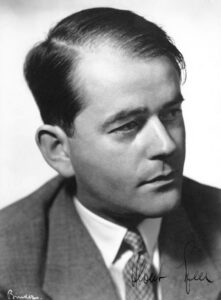 As Hitler continued his reign of terror over the people of Germany, in his quest to rule the world, he decided that he needed to destroy much of the German infrastructure so that the Allied forces couldn’t use it as they penetrated deep withing the borders of Germany. Hitler must have known by now that he was losing this war, even in his crazed state, so he was trying to find a way to turn the tide.
As Hitler continued his reign of terror over the people of Germany, in his quest to rule the world, he decided that he needed to destroy much of the German infrastructure so that the Allied forces couldn’t use it as they penetrated deep withing the borders of Germany. Hitler must have known by now that he was losing this war, even in his crazed state, so he was trying to find a way to turn the tide.
The Nero Decree (German: Nerobefehl) was the order issued by Hitler on March 19, 1945, right after the Allies captured the final bridge on the Rhine River that allowed access into Germany. The Nero Decree ordered the destruction of large numbers of bridges in Germany. The official name was Decree Concerning Demolitions in the Reich Territory (Befehl betreffend Zerstörungsmaßnahmen im Reichsgebiet), but that is rather a long name, so it became known as the Nero Decree, after the Roman Emperor Nero, who, according to an apocryphal story, “engineered the Great Fire of Rome in 64 AD.”

This act would have wiped out all of Germany’s industry and infrastructure just to keep it from falling under Allied control. Hitler didn’t care about that or about the people who would be affected. The actual task of carrying out such destruction fell to Germany’s armaments minister…and Hitler’s friend, Albert Speer. Speer knew that to follow the order would have a ruinous effect on the German people, so like Von Choltitz, who had disobeyed the order to burn Paris, Speer deliberately disobeyed the order of his friend, who he suspected was mentally unstable. In addition, Speer also issued encrypted alternate orders to delay the destruction. In the end, the Nero Decree wasn’t carried out at all, something which I’m quite certain drove Hitler totally insane.
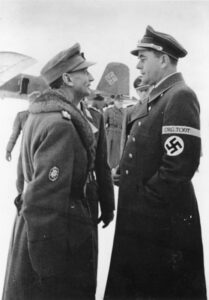
Speer was one of the highest-ranking members of German leadership to survive the war. He attempted to promote himself as someone who stood up to Hitler. While history does credit him with refusing to follow the Nero Decree, it did not completely exonerate him. Speer was an architect, and he wanted to preserve many buildings he had designed. Berthold Konrad Hermann Albert Speer, born March 19, 1905, in Mannheim, into an upper-middle-class family. He was the second of three sons of Luise Máthilde Wilhelmine (Hommel) and Albert Friedrich Speer. He was a German architect who served as the Minister of Armaments and War Production in Nazi Germany during most of World War II. He was also a close ally of Adolf Hitler, a relationship which would cause him to be convicted at the Nuremberg trials and sentenced to 20 years in prison. Speer returned to London in 1981 to participate in the BBC Newsnight program. He suffered a stroke and died in London on September 1, 1981.
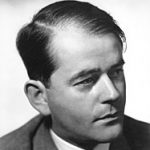
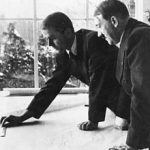 As the chief architect and minister for armaments and war production, Albert Speer designed many of the great buildings that Hitler craved. Hitler loved having the very best. Hitler was always impressed by academic credentials and any kind of artistic or technical talent, so he made Speer his personal architect. Albert Speer was born March 19, 1905, in Mannheim, Germany. At the age of 22, he received his architectural license, having studied at three German technical schools. He became an ardent Nazi after hearing Hitler speak at a rally in late 1930, and joined the party in January 1931. It was his decision to become a Nazi that gave him the opportunity to be noticed by Hitler.
As the chief architect and minister for armaments and war production, Albert Speer designed many of the great buildings that Hitler craved. Hitler loved having the very best. Hitler was always impressed by academic credentials and any kind of artistic or technical talent, so he made Speer his personal architect. Albert Speer was born March 19, 1905, in Mannheim, Germany. At the age of 22, he received his architectural license, having studied at three German technical schools. He became an ardent Nazi after hearing Hitler speak at a rally in late 1930, and joined the party in January 1931. It was his decision to become a Nazi that gave him the opportunity to be noticed by Hitler.
It was the fact that he now worked for Hitler, that gave him the power he craved for himself. Hitler began a massive Berlin building program. Among the projects the Fuhrer entrusted Speer with was the design of the parade grounds for the Nuremberg Party Congress in 1934, which Leni Riefienstahl made famous in her famous propaganda film Triumph of the Will. As minister of armaments and munitions, Speer’s job description expanded to include not only armament production and transportation, but also the direction of raw material use and finally the conscription of slave labor, culled from concentration camps, for war material production. On this day, November 21, 1941, Speer approached Hitler, and asked for 30,000 Soviet prisoners to be slave labor for his projects,telling Hitler that these slave laborers would come in handy for his “new” Berlin. Speer wanted to begin construction even as the war waged. Despite the drain on resources Hitler agreed. Speer beguiled the Fuhrer with models of a Great Hall for the Chancellery and a grand office for Goering. I find it strange to think that someone finally pulled a few things over on Hitler, who always seemed to have the upper hand.
The program was going well, but the times were not in Speer’s favor, or Hitler’s. The war turned against Nazi Germany, the rebuilding plans were scrapped. When the war was over, Hitler was dead by his own hand, and Speer was tried as a war criminal at Nuremberg, the site of his grand parade, and sentenced to 20 years in prison for his role in the Nazi regime, principally for the use of forced labor. Despite repeated attempts to gain early release, he served his full sentence, most of it at Spandau Prison in West Berlin. Following his release in 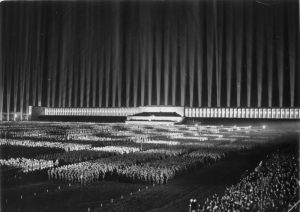
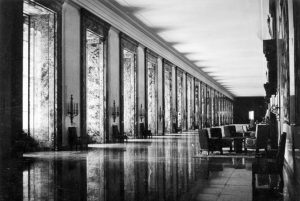 1966, Speer published two bestselling autobiographical works, Inside the Third Reich and Spandau: The Secret Diaries, detailing his close personal relationship with Hitler, and providing readers and historians with a unique perspective on the workings of the Nazi regime. He wrote a third book, Infiltration, about the SS. Speer died of a stroke in 1981 while on a visit to London.
1966, Speer published two bestselling autobiographical works, Inside the Third Reich and Spandau: The Secret Diaries, detailing his close personal relationship with Hitler, and providing readers and historians with a unique perspective on the workings of the Nazi regime. He wrote a third book, Infiltration, about the SS. Speer died of a stroke in 1981 while on a visit to London.

